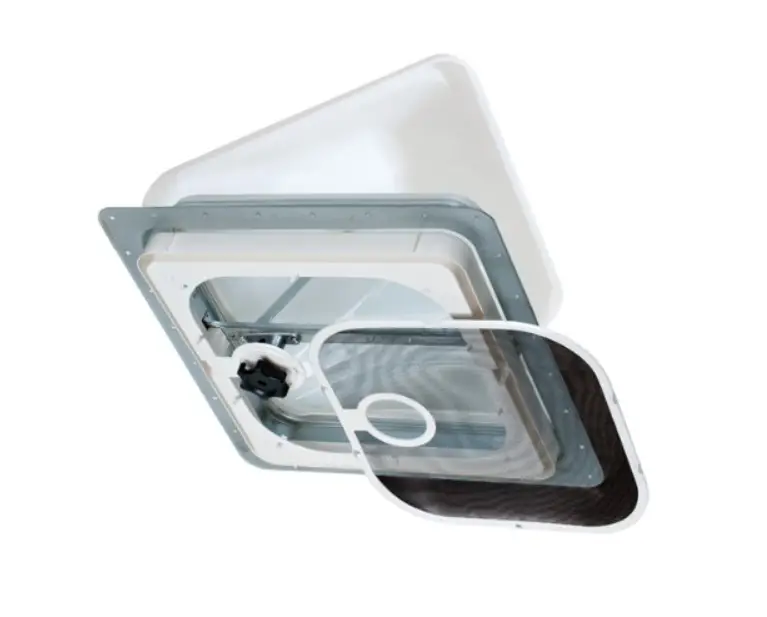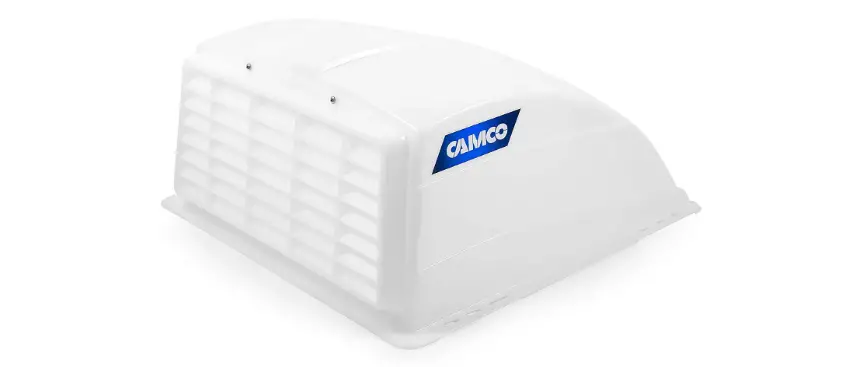
7 Best Roof Vent Fans and Covers
Without proper ventilation, RVs can get pretty stuffy. The air gets stale and suffocating from the accumulated cooking smells, shower steam, etc. If you want to keep the atmosphere in your RV fresh and breathable, you must install a roof vent fan and cover.
Roof vent fans help with air circulation whether you’re driving your RV or simply parked in a camp. Roof vent fans and covers are also important during the winter months as they can dispel moisture and prevent mold growth.
There are a number of roof vent fans and covers on the market. You need to be careful about the ones you choose, especially if you have pets or little kids on board. The two main types of RV roof vent fans are electric and non-electric. They are generally 14”x14” in size. Below I will take a look at some of the top choices in both of these categories.
There are number of reasons why you may want to get a roof vent fan for your RV.
- Getting Rid of Stale Air: Without air circulation, the environment within your RV will become hot and stale. Air from sources like shower steam, cooking gas, CO2 exhale, etc, will accumulate and create an unhealthy and unpleasant atmosphere. A roof vent fan can pull all the stale air out of the RV and bring in fresh air.
- Getting Rid of Odors: The odor from various sources — pets, laundry, cooking, sweat, etc — can accumulate much like stale air. Most of these odors can be removed through proper ventilation.
- Keeping it Cool: Have you ever gone camping in the summer? If so, you probably know how hot it can get in a RV. Sure, you can cover the windows and drink cool water, but that won’t make a noticeable difference. An AC will lower the temperature but it won’t do anything to get rid of stale air. The best way to keep your RV fresh and cool is to install an RV vent fan. It works by pushing the hot air out of the RV and pulling in relatively cooler air from the outside.
- Lower Humidity: RVs can get really humid, especially during the rainy season. If you are drying wet clothes or bathing in the bathroom, you might experience some water stagnation. However, roof vent fans can dry out wet areas and moderate the humidity so your RV doesn’t feel damp.
Once you have your roof vent fan installed, you will need to get a cover for it. This will help you:
- Keep Pests Out: Pests and insects love to make their nests in RV vents. If you’re storing your RV until your next trip, you should protect the roof vent with covers so your RV doesn’t become a breeding ground for pests.
- Protect from the Rain: When it’s raining, you can’t use vents as all the water will seep into your RV. However, if you close them, all the air will get trapped inside. However, if you install an RV roof vent cover, you can use your vents even when it’s raining.
- Storage: What do you find when you retrieve your RV after storing it for a long period of time? If the vents are closed, the air inside is musky and fetid. If you left the vents open, you’ll find the RV full of insects. However, if you use RV vent covers, you can crack open the vents and make sure that the RV is in better condition when the time comes.
Table of Contents
Best Electric Roof Vent Fans
An electric vent is one that runs on 12-volts of power. It can function on several speed settings and be customized to both draw in or push out air. As such, you can first push the foul air out and then trigger the suction to pull fresh air in. Some electric vents come with rain covers and sensors, while some are also equipped with thermostats so you can regulate the internal temperature.
Since electric vents run on 12-volts electricity, you need to connect them to an external battery. They can also generate noise and are generally more expensive than the non-electric alternatives.
1. Maxxair MaxxFan Deluxe
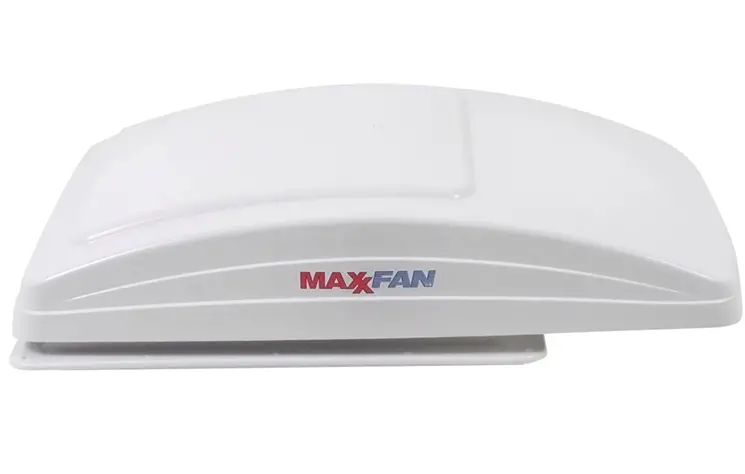 The Maxxair MaxxFan Deluxe is universally hailed as the most advanced and feature-heavy electric roof vent fan for RVs. This product offers you several options. First, in terms of color, you can get a white or a smoke-colored vent. Second, you can get one in which the lid is operated manually or handled electronically via a remote.
The Maxxair MaxxFan Deluxe is universally hailed as the most advanced and feature-heavy electric roof vent fan for RVs. This product offers you several options. First, in terms of color, you can get a white or a smoke-colored vent. Second, you can get one in which the lid is operated manually or handled electronically via a remote.
The best aspect of this vent fan is the abundance of features offered. This is one of the few RV vents on the market that comes equipped with a rain vent cover attached to the fan. This completely eliminates the need for a separate rain vent cover.
My favorite feature is the ceiling fan option. The Maxxair MaxxFan Deluxe gives you the ability to run the fan even when the rain vent cover is closed. This prevents the vent from pulling air from outside, but it circulates the air within the RV, acting as a regular fan. This feature is ideal for use in cold weather as it prevents the RV from pulling in cold air or dispelling the hot air within.
The rain vent cover has been designed in such a manner that you can open up the vent even when it’s raining so your vent won’t get wet. With most other vents, if you intend to open them when it’s raining, you have to purchase a separate rain vent cover. Furthermore, the vent cover is held in place by twin lifting arms so it doesn’t flap or flutter in the wind. This roof vent fan is extremely easy to clean because the bug screen can easily be removed to clean the fan.
Now that I’ve gushed over all the features I love, it’s time to discuss some of the major issues with this product. The infrared remote is designed well and has an inbuilt LED screen that provides details like room temperature, the speed of the fan, etc. You can also use the remote to flip between 10 different speed settings. However, as an infrared remote, it can only function with true a line of sight, so it needs to be pointed directly under the fan to work. If you need to operate the remote from your bed or couch, you can’t.
My biggest concern is that it starts making a loud noise when you use it at speed settings over 50%. This happens as a result of harmonic issues, i.e., the fan rattles when slightly off balance. This can be a nuisance when you’re sleeping at night.
Pros
- equipped with a rain vent cover.
- vent fan can also work when the cover is closed.
- twin lifting arms provide stability.
- can work even when it’s raining.
- pet-friendly because it comes with a rain cover but no rain-sensor that can automatically close the lid when it’s raining.
Cons
- too noisy.
- remote control doesn’t have a strong reach.
2. Fantastic Fan Vent 7350
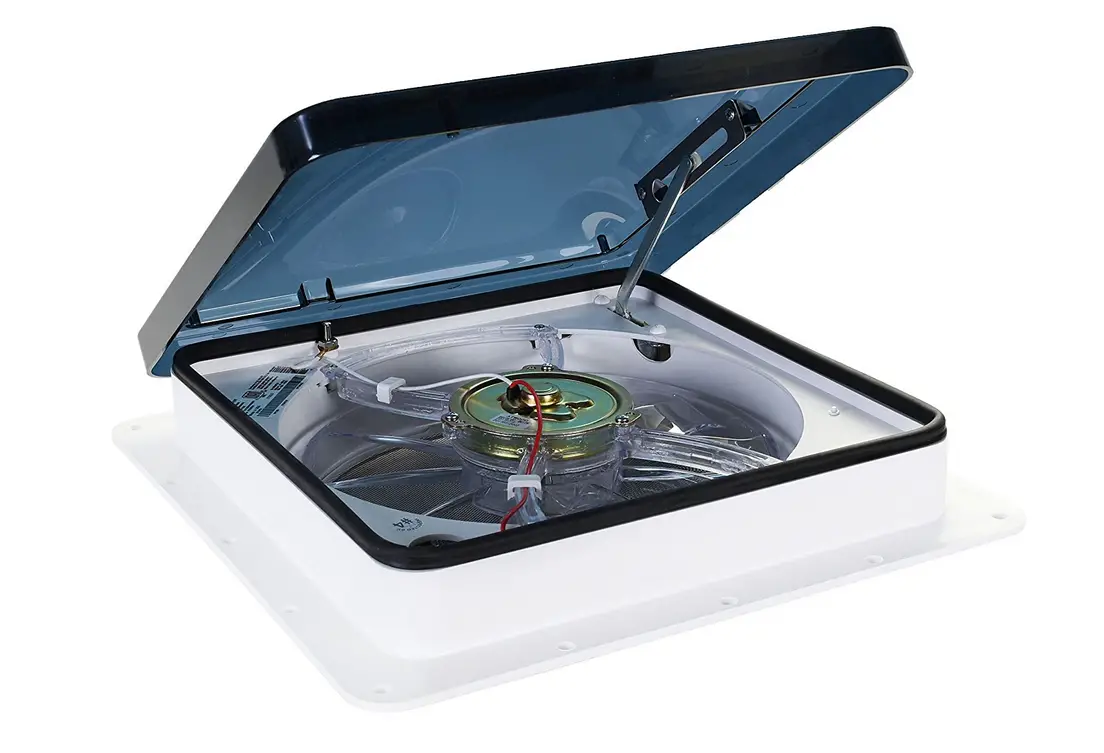 The aforementioned Maxxair MaxxFan Deluxe has one major issue — noise. If that is a dealbreaker for you, then you’ll love the Fantastic Fan Vent 7350. It’s the quietest electric RV vent fan on the market that provides 920 CFM (cubic feet per minute) airflow. In addition to being quiet, it has various advanced features like 13 fan speed settings, automatic lift dome, inbuilt thermostat, reversible airflow, rain sensors, and remote control.
The aforementioned Maxxair MaxxFan Deluxe has one major issue — noise. If that is a dealbreaker for you, then you’ll love the Fantastic Fan Vent 7350. It’s the quietest electric RV vent fan on the market that provides 920 CFM (cubic feet per minute) airflow. In addition to being quiet, it has various advanced features like 13 fan speed settings, automatic lift dome, inbuilt thermostat, reversible airflow, rain sensors, and remote control.
Fantastic Fans are some of the most respected and reliable vent fans on the market. With 13 different fan speeds, this vent fan can completely dry off a wet RV within a few short minutes. However, as you speed up the fan, the amount of noise produced also increases slightly. But you won’t need to worry about any sound produced for up to over 50% of the speed setting, which is still more than enough to circulate air in the RV and keep your atmosphere fresh.
My biggest issue here is the lack of manual controls on the fan. The less-advanced versions of the Fantastic Fan Vent — those without a remote control — come equipped with manual controls. The Fantastic Fan Vent 7350 is the most advanced version in this line of fan vents, and it comes with a remote, but no manual controls. As such, you should be very careful with the remote since it is the only way to control the fan. I also didn’t appreciate that the remote doesn’t come with an LED screen. So you have no way of knowing for sure the speed setting you’re at. In terms of remote features, the Maxxair MaxxFan Deluxe was a lot better.
The Fantastic Fan Vent 7350 comes equipped with rain sensors in lieu of a rain cover. As such, whenever the vent discovers that it’s raining, it automatically closes the lid, so no water can get in. This feature can be useful or disadvantageous. If you’re a pet owner, you should not get a vent with a rain sensor since the vent could get closed and there would be no air circulation within the RV. If you own pets, the Maxxair MaxxFan Deluxe is a better alternative.
Pros
- extremely quiet.
- comes with 13 speed settings.
- rain sensor can close the vent when it’s raining.
Cons
- not pet-friendly as the rain sensors can automatically close the lid after a quick shower, and the pets will be trapped inside without air circulation.
- remote control doesn’t have an LED screen.
- no manual controls available.
- no rain cover provided.
3. Hengs Industries Universal Vent
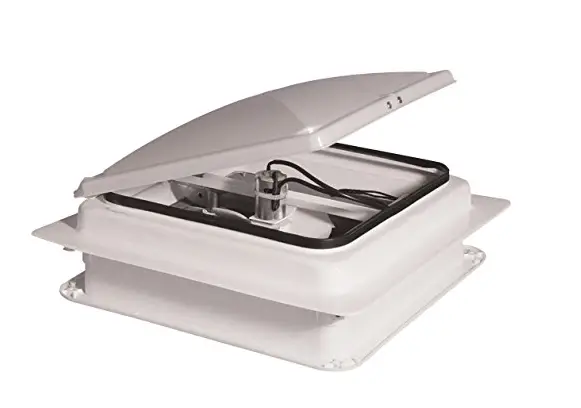 This Hengs Industries Universal Vent works on 12-volts of electricity. It has the standard 14” x 14” dimensions and comes with a bug screen. It has a galvanized metal base that can increase the vent’s durability.
This Hengs Industries Universal Vent works on 12-volts of electricity. It has the standard 14” x 14” dimensions and comes with a bug screen. It has a galvanized metal base that can increase the vent’s durability.
This vent is extremely energy-efficient, drawing only 1.2 amps when the motor is extremely cold. In most conditions, it draws less than one amps of energy. This roof vent is electric but it doesn’t come with any advanced features. The electricity is only used to power the fan. Other than that, there’s no speed controls, no remote control, and the lid has to be opened using a hand crank. As such, it’s just one step above a non-electric roof vent.
You should also note that this vent can only blow air out. It’s not meant for sucking air in. If you want to facilitate airflow by bringing in fresh air, you should crack open some windows. I was disappointed that they didn’t provide the necessary installation tools with the product. You’ll have to purchase the self-tapping screws and butyl tape yourself.
This roof vent is also not extremely durable. If exposed to direct sunlight for an extended period — which is inevitable considering it is installed on the roof — the cheap plastic will start cracking within a few months. Within a few months, you’ll have to start looking for a replacement.
Pros
- cheapest electric roof vent on the market.
- the galvanized metal base increases the product’s durability.
- weather-resistant.
- extremely energy efficient.
- relatively quiet, compared to most electric roof vents.
Cons
- has an extremely low CFM so it moves air slowly.
- the installation kit has to be bought separately.
- not reliable in how it works.
- not durable and starts cracking under continued exposure to the sun.
- no extra features like remote control and speed settings.
- the lid has to be opened with a hand crank.
- can only expel air from the RV, cannot pull air in.
Best Non-Electric Roof Vent Fans
Non-electric vents are manually handled and don’t need any external connections to function. They are generally cheap and don’t produce noise. They can also let in air from outside and dissipate internal air.
However, since there are no speed settings and you can’t trigger suction, the speed at which the air circulates is a lot slower. Some non-electric vents don’t even have a fan.
4. Ventline V2092SP-28
The Ventline V2092SP-28 is a non-electric roof vent fan. This static vent can be installed on the roof of an RV. Like all non-electric roof vents, it is fairly easy to operate. A lift mechanism is used to open or close the latch, and it’s fairly smooth in operation and doesn’t make any noise. It has a 2-piece snap-out screen that can easily be detached, so you can clean the insides of the vent and fan. The vent also comes with a roof vent cover ideal for the rainy season or pet owners. The cover can be detached easily by simply extracting the pins.
The installation is simple (once you figure it out) and the product comes with all the parts you need — frame, crank mechanism, plastic dome, screen, and garnish for the ceiling. However, the manufacturer should have provided a detailed set of instructions on how to install it. You have to remove the lid before installation, and the manufacturer should have included instructions on how to do that. It’s impossible to install the hinge side screws if the lid is in the way. This little error greatly increased the time it took for me to install the vent. Upon contacting other customers, I found this to be a recurring issue.
The interior part of the vent — the garnish — is 2.13 inches deep. The external part that inserts into the opening is 1 inch deep. As such, your roof will have to be at least 2.13 inches deep to be able to accommodate this; otherwise, the garnish will not fit on the ceiling comfortably. If the roof is a lot thicker, there will be a gap between the garnish and the external part, but that’s not much of an issue. This vent is made of plastic and rust-resistant aluminum. As such, you can even install it in bathrooms or other areas with high humidity without fear of it rusting.
Since this is a non-electric vent, there’s no fan in it. You simply have to open the vent lid and naturally allow the air to circulate. You cannot control a fan to facilitate this, and you have to allow nature to take its toll. Due to the lack of a fan, you also can’t control whether you pull in or expel air from the vent. However, on the bright side, you don’t have to worry about any wiring.
Pros
- reasonably priced.
- the crank handle is extremely sturdy.
- has a 2-piece removable screen.
- no wiring is necessary.
- no noise.
Cons
- no fan and no control over air circulation.
- lack of clear installation instructions.
5. Solar Wholesale Roof Vent
The Solar Wholesale Roof Vent is a solar powered roof vent fan. This isn’t a traditional 14” x 14” roof vent — it has a round shaped with a 4” diameter — so you’ll have to carefully check the perimeters and cut a space for it on your RV’s roof.
This vent will have to be installed in a spot that receives direct sunlight because that’s the only way the fan works. It is made completely of plastic so you have to be careful when handling it as it’s not the most durable vent. However, since it’s available for less than $30, I’m completely satisfied with it. It’s not meant for people who use their RVs on a regular basis. It is rather meant to be installed over toilets or in RVs that are used sporadically, as a temporary solution.
Since it is solar powered, this fan will only work when there’s sun out. The good news is that in most cases, you’ll only need the fan when it’s hot outside. Even if there’s no sun, air circulation will continue anyway through the grills. However, air circulation with this vent fan is extremely slow, so it will take quite a while for any humidity to be cleared. It can be used for clearing the humidity and preventing the temperature from rising too much.
If you don’t want to spend too much on an electric vent but still need a fan-operated vent, this is a good midway point between electric and most non-electric vents.
Pros
- fan is powered by solar energy.
Cons
- made of cheap plastic that breaks easily.
- air circulation is extremely slow.
- needs direct sunlight to work.
- the size is odd and you’ll either have to cut a space for it specifically or use caulk to seal the area around it.
Best RV Roof Vent Covers
6. Fan-Tastic Vent Cover
The Fan-Tastic Vent Cover is the ideal cover for RVs without a cover and for pet-owners. Using this roof vent cover will enable you to keep the roof vent open, even in the rain. This ensures that your RV doesn’t get wet while still facilitating air circulation. Note that this vent cover doesn’t come with a bug screen, so you should use it on vents that already have bug screens.
The Fan-Tastic Vent Cover is considered to be one of the best vent covers on the market, facilitating 75% more airflow than all others. It is made of high-density polyethylene and has UV protection. If you get the smoke-colored vent cover, the light coming through will be dimmed.
The biggest drawback here — and it’s a big dealbreaker for most people — is that the vent cover gets brittle over time. The cover will collect dust and dirt, and its ability to circulate air will be hindered. As such, it needs to be cleaned regularly. In addition, most users complain that the cover becomes extremely brittle within a few months and shatters upon contact. While my roof vent cover didn’t break, it did get extremely dirty, restricted the airflow, and I couldn’t adequately clean it in fear that it will shatter. If you want a vent cover that will last a couple of months, this is ideal. But if you’re looking for durability and longevity, look elsewhere.
Pros
- ideal for pet-owners.
- allows 75% more air circulation than most other roof vent covers.
- provides UV protection.
Cons
- gets extremely brittle with age.
- hard to clean it thoroughly without shattering it.
- bug screen not available.
7. Camco RV Roof Vent Cover
The Camco RV Roof Vent Cover is an easily mountable roof vent cover designed in an aerodynamic style. It’s made of UV-immune resin that allows it to be used for years without fear of breaking or getting brittle. It also comes with removable louvers that can be used to clean the vent easily.
This roof vent cover is installed over the vent and allows you to open your vent even during the rainy season. It can stop rain from coming in while continuing to facilitate air flow. Installing this might be a little complex, especially since the manufacturer doesn’t provide all the tools necessary. You’ll need to get a pencil, a 3/16 inch bit drill, crescent wrench, and a Phillips head screw.
While this roof vent cover is UV stabilized, it’s not 100% immune to UV rays. I used it for a couple months and the vent cover didn’t get brittle; I could clean it easily enough. However, various users have noted that the cover gets brittle and might even break after about 4 years. That’s a hell of a long time for a cheap roof vent cover. So the Camco RV Roof Vent Cover is certainly much more durable than the Fan-Tastic Vent Cover.
If you live in an extremely hot location, it’s possible that the cover’s longevity might drop down to about 2 years. However, you can expand its life by running a clear coat of UV protective additives over it. That might restrict the airflow a little more, but it will certainly increase durability. You can also increase the longevity by keeping the RV in your garage or places with shade instead of parking it under direct sunlight.
Pros
- extremely durable.
- immune to UV rays.
- strong airflow.
- aerodynamic style.
Cons
- doesn’t come with all the necessary mounting tools.
Factors to Consider when Buying Roof Vent Fans
When buying roof vent fans, you need to consider the following factors.
Type
As mentioned, roof vent fans come in two types — electric and non-electric. Based on their specifications, you need to decide which is more suitable for your needs.
Power
If you decide to get an electric vent, you need to consider the power it needs. Roof vents don’t generally consume a lot of power. All of them run on 12-volt batteries and they pull just about 3 to 4 amperes of power even at the full speed setting. If you turn down the setting, most vents only consume 1 amp of power.
However, some vents come with two fans and generally consume a little more power. In this case, one of the fans is usually used to pull air in and the other is used to push the air out.
Size
Most RV roof vent fans come in a standard 14” x 14” size. However, if your RV already has space for a vent, you should measure it anyway to make sure you get a correctly-sized unit.
Features
RV roof vents may come with different features. You should purchase an RV vent with the maximum number of useful features. Some of those to consider include a remote control to handle the vent’s fan, variable speed settings, rain cover, and reversible blade rotation to pull air in or push it out.
Noise
Some electric vents generate a lot of noise. One of the primary reasons people replace the air vents provided by the RV manufacturer is because they come with small fans that produce too much noise. If you spend a considerable amount of time in your RV, it’s worth getting a quiet roof vent so you can get a good night’s sleep.
CFM
CFM refers to cubic feet of air per minute. The CFM rating indicates how much air the vent can move in a single minute, multiplied by the overall space in the RV. The higher the CFM, the higher the speed and the faster the humidity gets pulled from the RV.
Runtime
On average, a vent fan should be able to run on a battery for about 72 hours before it needs to be recharged. Be sure that the roof vent you get doesn’t have a drastically short battery runtime.
Lid Opening
Some RV vent fans come with manual lids and some come with automatic lids that can be handled via remote control. However, this isn’t a really big factor because it’s not too much of an effort to crack the vent open manually.
How to make sure your RV Vent Fan is Pet-Friendly
Do you have kids and pets in your RV? If so, you need to make sure your RV vent is pet-friendly. Vents are necessary if you have pets to prevent the RV from overheating, which could, in dire situations, even kill the pets. However, vents can be problematic if it starts raining because the RV will fill up with water.
To handle the weather, most people go for RV vents with a rain sensor. However, if you have pets, using a rain sensor is actually a bad idea because they close the vents entirely. When the sun comes back up, the RV will start heating up again and the vents will be closed.
To avoid this situation, the best thing to do is to attach a cover to your RV roof vent but avoid purchasing a roof vent with an automatic rain sensor.
Can I Drive with an Open Vent Fan?
Yes, you can drive with an open vent fan. However, there are two major drawbacks to consider.
- Lower Efficiency: If your vent is open, you might pick up some wind resistance. As such, your vehicle might drag a little more than usual, which will, in turn, lower your fuel’s efficiency as you need to hit the accelerator more.
- Potential Damages: Enough wind and force sustained over a prolonged period of time could shake certain RV components loose or slowly warp them over time. If your RV vent fan breaks, for example, it could potentially harm the vehicle behind you. However, this is an extremely unlikely circumstance.
Why is an RV Vent Fan Better Than an RV AC?
An RV vent fan is a more favorable alternative to an AC for a number of reasons:
- An AC battles the heat within the RV by generating cool air, which consumes a lot of electricity. A vent fan, however, dissipates the heat and consumes a lot less electricity.
- RV vent fans suck the hot air out of the RV and release it outside. This instantly cools the vehicle. An AC, in comparison, has to combat the hot air inside, which is an endless process.
- An AC can potentially increase the humidity within your RV whereas a vent fan eliminates it.
- RV vent fans can also eliminate all odors, something ACs cannot do.
- ACs take up a lot of space, whereas RV vent fans installed on the roof take up no space at all.
We’re not suggesting that you shouldn’t use ACs. However, you should only rely on ACs if it’s extremely hot outside and you need to considerably chill the air instead of simply getting rid of hot air.
How to Clean RV Roof Vent Fans?
Roof vents are rendered practically useless if they’re dirty. Furthermore, because of their position in your RV and their purpose, they generally get dirty pretty fast. As such, you’ll have to clean your RV roof vent fans rather often, approximately once every two weeks. The following are your options.
Quick Clean — Once in Two Weeks
Run a vacuum hose gently over the screen underneath the blades. This will remove all accumulated dirt. If you have a model wherein you can remove the screen easily, you can also use a damp paper towel to clean the surface of each blade. This process shouldn’t take more than a few minutes.
Deep Clean — Once a Year
In order to deep clean your vent fan, you might have to disassemble it. The process should take about 30 minutes. You’ll need paper towels or rags, window cleaner spray, and a brittle brush.
You can clean the vent through the following steps:
- Take the screen off. Run water through the screen and allow it to air dry.
- Grab the top and bottom of the blades and gently wipe them clean with a paper cloth or rag.
- Now use the brittle brush to get rid of any dust left on the rims. The dust might fall down to the floor and you won’t be able to reach it.
- Once you’ve cleaned the vent fan completely, use a vacuum to suck all the remnants of dust from the blades and the vent’s floor.
- Replace the dry screen back where it should be.
After this is done, your vent fan will be good as new.
Safety Tips
Be sure that you turn the vent off when cleaning it. As a safety measure, disconnect the vent and warn everyone in your RV that you’re cleaning the vent. If someone turns it on while you’re cleaning the fans… well, that could get messy.
Conclusion
I hope this article has helped you decide which is the best roof vent fan and cover for your RV’s needs. As you can see, there are a lot of options, so choose wisely! And keep your RV fresh and well-ventilated!



